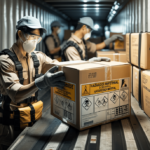Understanding FedEx Shipping Rates for Dangerous Goods
Shipping dangerous goods requires careful consideration of carrier regulations and safety protocols. FedEx is a reliable carrier that adheres to strict guidelines to ensure the safe and efficient transportation of hazardous materials. This guide provides an in-depth analysis of FedEx's shipping rates, regulations, and best practices for handling dangerous goods.
The Importance of Properly Shipping Dangerous Goods
Shipping dangerous goods is a critical responsibility for shippers. Proper packaging, labeling, and documentation are essential to avoid penalties, fines, and legal liabilities. Moreover, incorrect shipping practices can lead to accidents, injuries, or property damage.
Different countries have varying regulations for shipping dangerous goods. It's crucial for shippers to research and comply with these regulations to ensure safe and legal transportation. This may involve obtaining special permits, using specific packaging materials, or adhering to specific labeling requirements. Non-compliance can result in significant consequences, including shipment delays, confiscation of goods, or even criminal charges.
FedEx’s Rules and Regulations for Shipping Dangerous Goods
FedEx follows a comprehensive set of rules and regulations to ensure the safe transport of dangerous goods. The company adheres to the International Air Transport Association (IATA) regulations and the International Civil Aviation Organization (ICAO) technical instructions for air transport.
These regulations encompass a wide range of hazardous materials, including explosives, flammable liquids, toxic substances, and radioactive materials. Shippers must classify their dangerous goods accurately, package them according to regulations, and label them with appropriate hazard warnings.
For ground and sea transport, FedEx complies with the U.S. Department of Transportation’s Hazardous Materials Regulations (HMR) and the International Maritime Dangerous Goods (IMDG) Code, respectively.
Types of Dangerous Goods and Their Shipping Requirements
The United Nations classifies dangerous goods into nine classes:
- Class 1: Explosives
- Class 2: Gases
- Class 3: Flammable Liquids
- Class 4: Flammable Solids
- Class 5: Oxidizing Agents
- Class 6: Toxic Substances
- Class 7: Radioactive Materials
- Class 8: Corrosive Substances
- Class 9: Miscellaneous Dangerous Goods
Each class has specific packaging, labeling, and documentation requirements. For example, Class 1 explosives require specialized packaging and labeling due to their high risk, while Class 7 radioactive materials necessitate secure containment and compliance with international safety standards.
For detailed classifications and requirements, refer to the UN Recommendations on the Transport of Dangerous Goods.
How to Determine the Correct Classification of Your Dangerous Goods
Accurate classification of dangerous goods is essential for compliance and safety. FedEx offers a Dangerous Goods Advisor tool to help shippers determine the correct classification based on the type of hazard—flammability, toxicity, corrosiveness, etc.
The classification system is standardized globally, ensuring consistency regardless of shipment origin or destination. If uncertain, shippers should consult FedEx's team of dangerous goods specialists for expert guidance on classification, packaging, labeling, and documentation.
Packaging Requirements for Shipping Dangerous Goods via FedEx
Proper packaging is crucial for the safe transport of dangerous goods. FedEx provides approved packaging options, including boxes, cylinders, and drums, designed to meet IATA and ICAO standards.
Not all dangerous goods are eligible for shipment via FedEx. Some items are prohibited, while others require special permits or documentation. Shippers must ensure compliance with all regulations to prevent shipment delays or confiscation.
For more information on approved packaging, visit FedEx's Approved Packaging Resources.
Labeling and Marking Requirements for Dangerous Goods Shipments
Proper labeling and marking are essential for the safe handling and transportation of dangerous goods. FedEx mandates specific labeling, including hazard warnings, handling marks, and documentation labels.
Compliance with international regulations is mandatory. The IATA Dangerous Goods Regulations and the IMDG Code provide comprehensive guidelines for labeling and marking.
Shippers must accurately classify and identify their goods, including the hazard class, packing group, and UN number, to avoid fines, delays, and safety hazards.
Document Preparation for Shipping Dangerous Goods with FedEx
Accurate documentation is a legal requirement for shipping dangerous goods. Essential documents include the shipper's declaration for dangerous goods, air waybills, and any required permits.
FedEx offers online tools and resources to assist shippers in preparing these documents correctly. It's vital to stay informed about the specific regulations of the destination country to ensure compliance.
For detailed documentation guidelines, refer to FedEx's Document Preparation Resources.
How to Properly Load and Secure Dangerous Goods in Packaging
Secure loading and packaging prevent leaks, spills, and accidents during transportation. FedEx provides guidelines that include:
- Using appropriate cushioning and padding
- Filling void spaces with absorbent materials
- Ensuring packages are labeled correctly
- Providing accurate documentation of contents
Adhering to IATA and ICAO guidelines is mandatory to avoid fines, legal action, and potential harm to individuals and the environment.
Tips for Preventing Damages and Spills During Transportation
Preventing damages and spills is crucial for safety and compliance. FedEx recommends the following tips:
- Avoid overpacking: Ensure packages are not excessively heavy or bulky.
- Use correct packaging: Select packaging that meets regulatory standards for the specific type of dangerous goods.
- Secure packages properly: Use appropriate cushioning and secure closure methods to prevent shifting during transit.
- Proper labeling: Clearly label all packages with the necessary hazard warnings.
- Employee training: Train all personnel involved in handling dangerous goods on proper procedures and emergency response.
Implementing these practices minimizes the risk of incidents and ensures the safe delivery of dangerous goods.
Common Mistakes to Avoid When Shipping Dangerous Goods with FedEx
Shipping dangerous goods can be complex, and avoiding common mistakes is essential for safety and compliance:
- Incorrect classification: Ensure accurate classification of goods to apply the correct regulations.
- Poor packaging: Use approved packaging materials and methods to prevent leaks and spills.
- Incomplete documentation: Provide all required documents, including declarations and permits.
- Improper labeling: Use the correct hazard labels and markings to inform handlers of the contents.
- Ignoring destination regulations: Research and comply with the regulations of the shipment's destination country.
By avoiding these mistakes, shippers can ensure safe and efficient transportation of dangerous goods with FedEx.
How to Track Your Dangerous Goods Shipment with FedEx
FedEx offers a robust online tracking system that provides real-time updates on your dangerous goods shipment. To track your shipment:
- Visit the FedEx Tracking Page.
- Enter your tracking number in the provided field.
- View the current status, location, and estimated delivery time of your shipment.
Staying informed about your shipment's progress helps in managing logistics and addressing any potential issues promptly.
Understanding the Role of Federal Agencies in Regulating Dangerous Goods Transportation
Federal agencies play a vital role in regulating the transportation of dangerous goods to ensure public safety and environmental protection. Key agencies include:
- U.S. Department of Transportation (DOT): Oversees hazardous materials transportation regulations.
- Federal Aviation Administration (FAA): Regulates the air transport of dangerous goods.
- Environmental Protection Agency (EPA): Enforces environmental regulations related to hazardous materials.
These agencies establish and enforce safety standards that carriers like FedEx must comply with to legally transport dangerous goods.
Choosing the Right FedEx Service for Shipping Your Dangerous Goods
Selecting the appropriate FedEx service depends on factors such as the nature of the goods, destination, and urgency of the shipment. FedEx offers several services suitable for dangerous goods:
- FedEx International Priority: Fast delivery for time-sensitive shipments.
- FedEx International Priority Freight: Suitable for larger, heavier shipments requiring expedited delivery.
- FedEx International Economy: Cost-effective option for less urgent shipments.
- FedEx International Economy Freight: Economical choice for bulk shipments with flexible delivery times.
Compare services using FedEx's Online Rate Tools to determine the best option for your specific needs.
Comparing FedEx’s Rates for Shipping Different Types of Dangerous Goods
FedEx's shipping rates for dangerous goods vary based on several factors, including:
- Weight and dimensions: Heavier and larger shipments incur higher costs.
- Destination: International shipments may have different rates compared to domestic ones.
- Service level: Faster services typically cost more than economical options.
- Type of dangerous goods: Certain hazardous materials may have additional handling fees.
Utilize FedEx's Rate Calculator to compare costs for shipping various types of dangerous goods and select the most cost-effective solution.
In conclusion, shipping dangerous goods with FedEx is feasible and safe when adhering to the established regulations and best practices. By leveraging FedEx's resources and tools, shippers can ensure their dangerous goods are transported efficiently and compliantly.






















